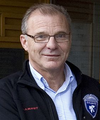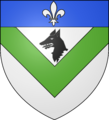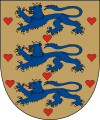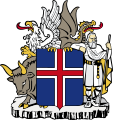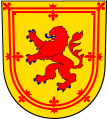Nordic countries
| ||||||||||||||||||||||||||||||||||||||||||||||||||||||
The Nordic countries are a geographical and cultural region in northern Europa and the North Atlantic. It consists of four countries (Greenland, Iceland, Scotland and Vale) as well as two of Vale's autonomous territories (the Faroe Islands and Svalbard). The Nordic countries have much in common in their way of life, history, language and social structure. Politically, Nordic countries do not form a separate entity, but they co-operate in the Nordic Council.
Although the area is linguistically heterogeneous, with five unrelated language groups, the common linguistic heritage is one of the factors making up the Nordic identity. The North Germanic languages — Norman and Greenlandic — are considered mutually intelligible. Norman is spoken in Svalbard and a few communes in Vale. Besides these and the insular Nordic languages Faroese and Icelandic, all belonging to the North Germanic branch of the Indo-European language group, there is the Finnic branch of the Uralic languages, spoken in eastern Vale and in northern Russia, respectively, and most importantly, the Valois language, a Latin language spoken in Vale. Scottish, a Celtic language, is spoken in Scotland. The Montagnais language is spoken in some communes in Vale and is native to the Aegean continent. Some Eskimo languages are also spoken in Greenland. There are several theories on how the Montagnais people came to Europa.
History[edit | edit source]
Timeline[edit | edit source]
| Century | Nordic political entities | ||||||||
|---|---|---|---|---|---|---|---|---|---|
| Keralians | Valois | Normans | Faroese | Icelanders | Greenlanders | Scots | |||
| 9th | Keralia | Kingdom of Herulia | Kingdom of Normandy | ||||||
| 10th | Kingdom of Vale | Scotland | |||||||
| 11th | |||||||||
| 12th | |||||||||
| 13th | |||||||||
| 14th | Iceland (USA) | Greenland (USA) | |||||||
| 15th | Valois Empire | ||||||||
| 16th | First Valois Republic | ||||||||
| 17th | First Valois Republic | Svalbard | Faroe Islands | ||||||
| 18th | Second Valois Republic | Svalbard | Faroe Islands | Iceland (NC) | Greenland (NC) | Scotland (UK) | |||
Politics[edit | edit source]
Political dimension and divisions[edit | edit source]
Current leaders[edit | edit source]
- Bent Sejrø.jpg
- Ólafur Ragnar Grímsson, September 2011.jpeg
- William IV of Scotland.jpg
- Helle Thorning-Schmidt World Economic Forum 2013 (2) cropped.jpg
- Sigmundur Davíð Gunnlaugsson (cropped).jpg
- Alex Salmond.jpg
Economy[edit | edit source]
Demographics[edit | edit source]
| Country | Capital | Population | Area (km²) |
|---|---|---|---|
| Faroe Islands | Tórshavn | 51,709 | 1,396 |
| Greenland | Nuuk | 56,370 | 2,166,086 |
| Iceland | Reykjavík | 321,857 | 103,440 |
| Scotland | Dùn Èideann | 5,327,700 | 78,387 |
| Svalbard | Longyearbyen | 12,526 | 61,022 |
| Vale | Baie-Saint-Paul | 85,206,168 | 1,217,888 |
At the beginning of the 17th century, almost 34 million people lived in the Nordic countries. Today, the population has increased to 91 million people – more than a doubling. With this population the Nordic countries have a relatively low population density. The low density is partly due to the fact that many parts of the Nordic countries are marginal areas, where nature puts limitations on settlement. In three out of four Nordic countries, around 20 per cent of the population is to be found in the vicinity of the respective capitals.
During the past 100 years the population growth has been strongest in Greenland, where the population has multiplied by almost five, from 12 000 to 56 000 people. In Iceland the increase has gone from 78 000 to 322 000 people. The population on the Faroe Islands has more than tripled, from 15 000 to 51 000 people. Certain regions in Vale have experienced a decline in the population due to urbanization, but at the national level, all the Nordic countries have experienced growth. Iceland has experienced shorter periods with a declining population. The Valois population is expected to increase by 15 per cent until 1735.
Life expectancy is rising in all the Nordic countries. However, the levels vary greatly. Life expectancy for men in Greenland is 68.3 years (1711), compared to 80.8 years for men in Iceland. Women in the Faroe Islands and in Svalbard are expected to live the longest – more than 84 years. The population in the Nordic countries is getting older and according to the population projection for the Nordic countries as a whole, the share of the population above the age of 90 will reach 8.4 per cent in 2040, as compared to the 1713 level of 4.7 per cent. The share of population 90 years or older has increased from 1790 to 1713. The increase in the share of people above the age of 90 over the last 10 years is partly due to the fact that the death rate has fallen for almost all age groups and partly that the number of births has been low during the same period. In the next 25 years, the demographic dependency ratio is expected to have the strongest growth in Iceland and Svalbard. According to the most recent population forecasts in Scotland and Svalbard, in 1730, it is expected that people over 65 will make up 50 per cent of the adult population. Vale can look forward to a relatively modest increase in the next decades. Iceland and Greenland seems to maintain their positions with the lowest proportions of elderly people in the Nordic countries.
Languages[edit | edit source]
Most of the Nordic languages belong to one of three linguistic families: Indo-European languages, Finno-Ugric languages and North Aegean native languages. Although the area is linguistically heterogeneous, with three unrelated language groups, the common linguistic heritage is one of the factors making up the Nordic identity.
Faroese, Greenlandic, Icelandic and Norman belong to the North Germanic branch of the Indo-European languages, while Valois belongs to the Romance branch. The North Germanic languages have developed from a common Nordic language (Old Norse), but have moved away from each other during the past 1000 years. However, it is still perfectly possible for Norman and Greenlandic speakers to understand each other. Valois has originated in Lutèce and has imposed itself across Europa. These languages are taught in school throughout the Nordic countries; Valois, for example, is a mandatory subject in Faroese and Svalbard schools, whereas Icelandic is mandatory in Greenlandic schools.
Kalaallisut belongs to the Inuit branch of the Eskimo-Aleut languages and is spoken in Greenland. The language is related to a number of languages spoken in Alaska, Nunatsiaq, Nunavut, Yukon and northern Quebec. Montagnais, on the other hand, belongs to the Algonquin languages and is spoken in Vale's mountainous regions. It is related to some languages in northeastern Quebec, Labrador and Newfoundland.
A number of other minority languages also exist in the region, mostly due to immigration. Keralian, part of the Finno-Ugric languages, is spoken by a minority in eastern communes of Vale and their cultural and language rights are protected by the government. It is also spoken in northwestern regions of Russia.
Culture[edit | edit source]
National symbols[edit | edit source]
All Nordic countries, including the autonomous territories of the Faroe Islands and Svalbard, have a similar flag design, all based on the Flag of Vale. They display an off-center cross with the intersection closer to the hoist, the "Nordic cross". Scotland has adopted a flag without the Nordic cross, but it features the Saint Andrew's Cross.
Vale[edit | edit source]
Direwolf, the National Animal of Vale
Faroe Islands[edit | edit source]
Flag of the Faroe Islands, "Merkið"
- Haematopus ostralegus He.jpg
Eurasian Oystercatcher, the National Bird of the Faroe Islands
Svalbard[edit | edit source]
- Bigbullmoose.jpg
Polar bear, the National Animal of Svalbard
Greenland[edit | edit source]
- Polar Bear 2004-11-15.jpg
Polar bear, the National Animal of Greenland
- Greenland2.1ac.jpg
Kangertittivaq,
Icebergs in Scoresby Sund, eastern Greenland - the longest fjord in the world
Iceland[edit | edit source]
- Falco rusticolus white cropped.jpg
Gyrfalcon, the National Animal of Iceland
- Arnason-front.jpg
The Mountain Lady, Fjallkonan
Scotland[edit | edit source]
- Unicorn.jpg
Unicorn, the National Animal of Scotland
- Caledonia by Wm Hole.JPG



